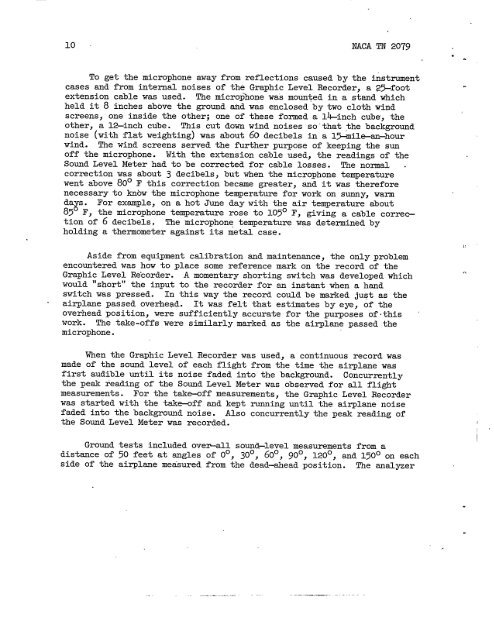Experiments in External Noise Reduction of ... - CAFE Foundation
Experiments in External Noise Reduction of ... - CAFE Foundation
Experiments in External Noise Reduction of ... - CAFE Foundation
You also want an ePaper? Increase the reach of your titles
YUMPU automatically turns print PDFs into web optimized ePapers that Google loves.
10 NACA TN 207’9●.To get the microphone away from reflections caused by the <strong>in</strong>strumentcases and from <strong>in</strong>ternal noises <strong>of</strong> the Graphic Level Recorder, a ~>foot .extension cable was used. The microphone was mounted <strong>in</strong> a stand whichheld it 8 <strong>in</strong>ches above the ground md was enclosed by two cloth w<strong>in</strong>dscreens, one <strong>in</strong>side the other; one <strong>of</strong> these formed a l~<strong>in</strong>ch cube, theother, a 12—<strong>in</strong>ch cube. This cut down w<strong>in</strong>d noises so’that ,thebackgroundnoise (with flat weight<strong>in</strong>g) was about 60 decibels <strong>in</strong> a 15-mil*an-hourw<strong>in</strong>d. The w<strong>in</strong>d screens served the further purpose <strong>of</strong> keep<strong>in</strong>g the sun<strong>of</strong>f the microphone. With the extension cable used, the read<strong>in</strong>gs <strong>of</strong> theSound Level Meter had to be corrected for cable losses. The normal .correction was about 3 decibels, but when the microphone temperaturewent above 800 F this correction became greater, and it was thereforenecessary to know the microphone temperature for work on sunny, warmFor exsmple, on a hot June day with the air temperature about~~s~, the microphone temperature rose to 105° F, giv<strong>in</strong>g a cable correction<strong>of</strong> 6 decibels, The microphone temperature was determ<strong>in</strong>ed byhold<strong>in</strong>g a thermometer aga<strong>in</strong>st its metal case.Aside from equipment calibration and ma<strong>in</strong>tenance, the only problemencountered was how to place some reference mark on the record <strong>of</strong> theGraphic Level Re’corder. A momentary short<strong>in</strong>g switch was developed whichwould “short” the <strong>in</strong>put to the recorder for an <strong>in</strong>stant when a handswitch was pressed. In this way the record could be marked just as theairplane passed overhead. It was felt that estimates by eye, <strong>of</strong> theoverhead position, were sufficiently accurate for the purposes <strong>of</strong>-this ‘work. The take-<strong>of</strong>fs were similarly marked as the airplane passed themicrophone.1!.When the Graphic Level Recorder was used, a cont<strong>in</strong>uous record wasmade <strong>of</strong> the sound level <strong>of</strong> each flight from the time the airplane wasfirst audible until its noise faded <strong>in</strong>to the background. Concurrentlythe pesk read<strong>in</strong>g <strong>of</strong> the Sound Level Meter was observed for all flightmeasurements. For the tak=ff measurements, the Graphic Level Recorderwas started with the tsk~ff and kept runn<strong>in</strong>g until the airplane noisefaded <strong>in</strong>to the background noise. Also concurrently the peak read<strong>in</strong>g <strong>of</strong>the Sound Level Meter was recorded.Grounddistance <strong>of</strong>side <strong>of</strong> thetests <strong>in</strong>cluded ove~all sound-level measurements from a50 feet at s<strong>in</strong>gles<strong>of</strong> 0°, 30°, 600, 90°, 120°, and 150° on eachairplane measured from the dead-ahead position. The analyzer..
















